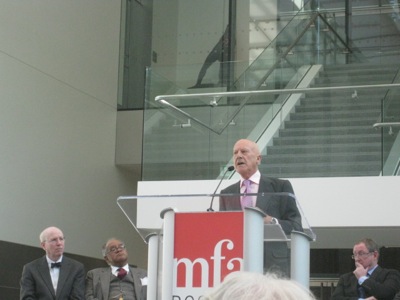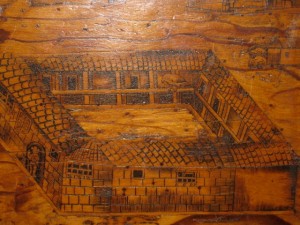
Art of the Americas Wing Opens at MFA Boston
The Art of the Americas Wing at Museum of Fine Arts Boston opened to the press on November 12th and to the public on November 21st. The 11-year-project of expanding the museum (ground broke in 2005) combined the ambitions of the British-born museum director, Malcolm Rogers, the board of trustees, and the architectural fiat of London-based Foster & Partners, led by Lord Norman Foster. On an unusually sunny Boston November morning the dais seats were occupied by politicians, patrons and an ecclesiast, Rev. Peter J. Gomes, whose flaring nostrils made me think of the pulpit chapter from Moby Dick (“I had not been seated very long ere a man of a certain venerable robustness entered”) – and Ishmaels conclusion that “the worlds a ship on its passage out, and not a voyage complete; and the pulpit is its prow.”

Lord Norman Foster
Lets follow the metaphor: A new museum inauguration as embarking ship (“not a voyage complete”), a bugle call heralded the trip downstairs of a gang of four: Rogers and Lord Foster, following Chairman and President of the Board of Trustees, Richard Lubin and Barbara Alfond. They paused midway down the stairs – a vertical promenade accessing four levels of galleries – for a photo op. Meantime the audience faced circumstance: Mass. Republican Senator Scott Brown, in a gray suit and blue tie, repeating the word “remarkable”; Boston Mayor Thomas Menino playing hometown cheerleader to the spoiler of 8th Congressional District Rep. Michael Capuanos anecdote that as a working-class Boston boy, he often passed the museum door but never felt welcome. Menino rose with the populist sentiment, “Art is for everyone. Enjoy.”
Watchful throughout sat the Rev. Gomes, “Pusey Minister in the Memorial Church of Harvard University.” As Gomes took the lectern, he asserted his own reverential pedigree: “Im talking to God.” The blessing came from the Chambered Nautilis (Oliver Wendell Holmes): “Build thee more stately mansions.”
But as David DArcy opened his piece in The National, it was not stately mansions the original tea partyers of Boston Harbor had in mind in 1773 as they tossed the tea overboard (and launched the American Revolution). That Boston remains, despite its locus as seedbed of American independence, very close to its Brit cousins across the pond, was just one more paradox of a day in which “whats in a name?,” Art of the Americas, began to offer a bifurcated answer to go with its expansion.

The old museum flanks the new glass building and sunlight reflects its facade onto the panels
It was surely stirring to behold the elegant Lord Foster touting the museums “equilibrium between the old and the new,” and the “bold strategy with a light touch” that had been the architectural mission. He said his firm sought to create galleries with the feel of “rooms,” to the tune of “10 separate interventions” and 53 new galleries on four levels. The project at $345 million expanded the museum exhibition space 28%, to 617,000 square feet. And indeed, the adjective “encyclopedic” recurred all day to describe the museums sense of its museum-world standing.
Again, the “newness” is the glass-walled atrium building in which a morning crowd of 1000 sat; the “light touch” its Vierendeel truss that holds up the structure. The old museum flanks the new glass building and sunlight reflects its facade onto the panels (a “state-of-the-art” glazing system Foster & Partners developed with Seele Inc. of Gersthofen, Germany) so that the classicism of the old cannot, even with ones back to it, be fully occluded. From the top floor opposite the executive offices you can look out to Fenway Park and the tidy architecture of Back Bay, and be reminded of Boston intellectualism, and Ralph Waldo Emersons eponymous poem (“We grant no dukedoms to the few/We hold like rights and shall/Equal on Sunday in the pew/On Monday in the mall/ For what avail the plough or sail/Or land or life/If freedom fail?”)
Okay. So now that freedom has entered in to the context of “Americas” – lets head (inevitably) back to the impartial voyage metaphor that serves (and should serve cautiously) to any striving to be custodian of world art. For, new architecture, encyclopedias and equalities notwithstanding, this new MFA Boston wing makes the “Americas” appear above all the unequal arts of the colonizing United States. One need only visit the Peabody-Essex Museum in nearby Salem for a closer look at the relationship of North America and Boston to plunderers who set out by sea to return with shrunken heads and stuffed penguins – a museum (Peabody-Essex) that is a 19th-century cabinet of wonders, remembering the colonizing methods that enshrined it here. There are no shrunken heads or stuffed penguins at MFA Boston, clearly. Yet this new wing has fallen short in several ways: First, in positioning its new collections to allow the category of “contemporary” art to define people whose ancestors may hail from the “ancient Americas,” but who themselves deserve not to be marginalized by virtue of their race. It is on the “lower ground” galleries where ancient American, Native American, 17th-century and maritime arts congregate – but there too live contemporary Native American arts of the late 20th-century and 21st centuries, rather than on the fourth level with the rest of the contemporary art.

Maya vessels
I enjoyed a close acquaintance with the patron who gifted much of the contemporary Native work to MFA Boston, Jim Krebs and his late wife, Mitch. But I had a nagging feeling throughout that if Jaune Quick to See Smith or Diego Romero were here to see their work encased at the rear of galleries that begin with spectacular Maya vessels and pass through Inca gold, Navajo silver, pre-Columbian dogs and other stone effigies, they might not fully buy Art of the Americas department chair Elliot Bostwick Daviss assertion that they are there because they “define themselves in a Native American tradition.”
Why should they be any different from contemporary artists who define themselves in, say, a tradition of Fluxus, or a design tradition having to do with 1900 Vienna Jungendstil? The explanation does not hold. And it reveals, in a nutshell, the museums discomfort with how precisely to position collections that leave open continually the question of which and whose Americas? Note in the photo above that the glass case holding this reliquary is stenciled with design motifs evidently meant to evoke the spirit of the objects on view. But I didnt see a great white stenciled around the painting Watson and the Shark (1778) by John Singleton Copley, or a background of Velasquezs Las Meninas plastered next to the mind-blowing Daughters of Edward Darley Boit (1882) by John Singer Sargent. As Disney-ification of the “Americas,” when they are not the early colonial United States, prevails, it does a disservice to taking objects beyond visuality.
At right, the detail of this escritorio or portable writing desk is a recent MFA acquisition (acquired from the U.S.) and dates from 1650-1700 Mexico. Made of rosewood with sumac infill, it has an iron lock and is thought to have gone east to France in the 17th-18th centuries. It maps the village of San Ildefonso in Oaxaca, and, per the curator, “uses the grain of wood to simulate landscape.” It was remarkably like pulling teeth to get the provenance out of the curator. One could now accuse me of provincialism for taking such a segmented view of an “encyclopedic” enterprise. Yet as soon as the museum departs from what seems to be its core purpose, to showcase the art of the birthplace-of-American-independence, it rapidly cedes encyclopedic claims and falls instead into the category of a 19th-century wunderkammerer or cabinet of wonders – wondrous and gorgeous to behold, but hardly displaying encyclopedic depth. Even as I stood looking at the object above, the escritorio, one of the Keno twins, an appraiser from Antiques Roadshow, came up too. It was all I could do not to ask, “Do you have any idea what this object is worth?”

Mexican escritorio or "portable writing desk"
Rewind to 1995 in Santa Fe when contemporary artist Richard Tuttle, working on a show for Museum of Fine Arts, delivered a talk offering a new view of the Americas along a “north-south” axis (disempowering the east-west cabal). Not long after that, I trekked to the old Customs House on lower Broadway and wrote a column for the Albuquerque Journal North on the National Museum of the American Indians then-temporary home there. In that building so full of colonial “context” – mercantilism, a trade route from lower Broadway extending up the Boston Post Road – the lobby with its striated marble floors and columns, and the portal with Greek gods holding sheafs of wheat, was easy to overlook – until you went on inside. There and then, I had something like a consciousness raising, even though Id already lived five years in New Mexico at the time. Celebrating Bostons new “jewel in the emerald necklace” – a reiterated allusion to the Fens and Frederick Law Olmstead, along with Guy Lowells master plan for the Classical MFA – I harked quite viscerally back to this experience.
There is no Egyptian or African marble at MFA. There is granite from Vermont and a glazing system that is sustainable and energy-conserving. And there is a venerable architect, and, enshrined in the rooms, a history of wealthy (possibly a late-capitalism word would be: oligarchical) art collecting that nevertheless have allowed we the people (and Rep. Capuano) to feel welcome inside. Yet one has to keep inquiring if “encyclopedic” is a fair self-assessment by this museum administration. And at the same time, reminding that where went the encyclopedia, now comes the “Wiki,” where the right to interpret now means others can edit not just for facts, maam, but points-of-view.
